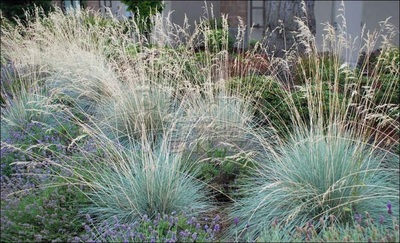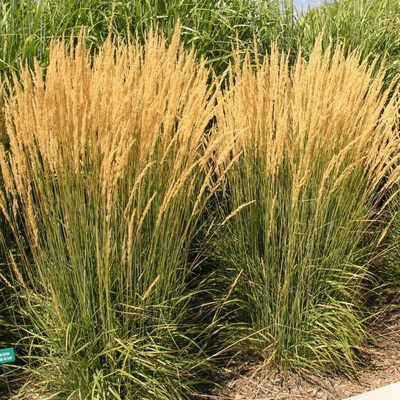There is an outstanding selection of ornamental grasses available to gardeners these days and with their graceful growing habit, long flowering and seasonal interest its easy to see why more and more gardeners are falling in love with ornamental grasses and the prairie style of planting
Ornamental grasses have increased in popularity over the last number of years due to their graceful beauty and easy maintenance playing an important role in design of landscape commercial projects and residential gardens. The size, colour, texture of foliage and flowers of a particular variety will determine its best use in a garden.
Ornamental grasses can provide good structure and calmness to the bold strong colours of perennial flowerbeds. Ornamental grasses fill spaces in flowerbeds with something that looks good and easy to care for and is low maintenance. Grasses can extend the flowering day and season of the garden creating different tones of light at different times of the day and year. If planted in a sunny aspect when the sun light is reflected on their leaves and flowering panicles and plumes they become the highlight of the garden. In winter ornamental grass can become the sole focal point in a garden when all perennials have died back and deciduous plants have lost their leaves. Morning time when frost sits on the panicles sunlight dances away and feather foliage sways in the breeze. The flowering panicles can also provide food for birds over winter.
Ornamental grasses have increased in popularity over the last number of years due to their graceful beauty and easy maintenance playing an important role in design of landscape commercial projects and residential gardens. The size, colour, texture of foliage and flowers of a particular variety will determine its best use in a garden.
Ornamental grasses can provide good structure and calmness to the bold strong colours of perennial flowerbeds. Ornamental grasses fill spaces in flowerbeds with something that looks good and easy to care for and is low maintenance. Grasses can extend the flowering day and season of the garden creating different tones of light at different times of the day and year. If planted in a sunny aspect when the sun light is reflected on their leaves and flowering panicles and plumes they become the highlight of the garden. In winter ornamental grass can become the sole focal point in a garden when all perennials have died back and deciduous plants have lost their leaves. Morning time when frost sits on the panicles sunlight dances away and feather foliage sways in the breeze. The flowering panicles can also provide food for birds over winter.
There are many different ornamental grasses that tolerate a wide range of conditions, but most prefer a sunny position, moist, well-drained fertile soil. Grasses would be considered low maintenance, requiring very little fertiliser, one application of fertiliser in spring and cutting back and tidying up dead leaves. There are cool season grasses and warm season grasses. Here are a few to try:
Cool season grasses start growing in early spring and can sometimes remain evergreen over the winter. They have better foliage quality and require more watering during drought periods. Frequent division is required to keep the plant healthy and prevent die back and rot in the centre of the plant
Cool season grasses include Fescues, Autumn Moor Grass (Sesleria) and Blue Oat Grass (Helictotrichon), Tufted Hair Grass (Deschampsia)
Cool season grasses start growing in early spring and can sometimes remain evergreen over the winter. They have better foliage quality and require more watering during drought periods. Frequent division is required to keep the plant healthy and prevent die back and rot in the centre of the plant
Cool season grasses include Fescues, Autumn Moor Grass (Sesleria) and Blue Oat Grass (Helictotrichon), Tufted Hair Grass (Deschampsia)
Blue oat grass (Helicototrichon sempervirens) is a small mound forming with grassy grey-blue leaves. It adapts and fits well in formal and informal designs. It is low maintenance, acts as a good ground cover and requires full sun. Its flowers reach to 3-5 ft. above the foliage and width is 2ft. Panicle flowers are golden brown spikelets.
Autumn Moor Grass (Sesleria) is a stunning eye catching mound of yellow green leaves. It likes full sun but will tolerate partial shade. It is clump forming, robust, making it the perfect ornamental grass for a small garden, but when planted in masses is absolutely beautiful. In mid-summer narrow stems emerge and the Panicles sway high above its clump in the breeze. Approx. height and spread is 2ft*2ft
Warm season grasses thrive when the weather is warmer and temperatures stabilise and do not require as much watering through the season. These grasses need cutting back in early spring to about 4-6 inches from ground level. Northern Sea Oats (Chasmanthium), Japanese Silver Grass, (Miscanthus sinensis), Hardy Pampas Grass (Erianthus), Perennial Fountain Grass (Pennisetum) and Mexican feather grass (Stipa’s)
Perennial Fountain grass (Pennisetum) is a very popular grass as it is easy to grow and is low maintenance. It is compact mound/clump forming grass with green arching leaves and produces spikes of mauve/lilac inflorescences in late summer /autumn carrying them through to winter when the leaves turn a buttery yellow colour. It is an excellent cut flower. It suits a full sun to partial shade site and will grow in normal clay or sandy soil. Height and spread is approximately 2*2 ft.
Japanese Silver Grass (Miscanthus sinensis “morning light”) is a beautiful ornamental grass. It has an upright compact clump forming habit with narrow green foliage. It is suitable for a small garden and would make a fantastic specimen and focal point within the garden. Its large distinctive flower plumes are deep pink in colour and are produced in late summer, early autumn. They require little attention apart from cutting back to 4 inches in early spring and root division every 3-5 years to reduce it size. It attracts butterflies, looks great at the back of boarders, in containers, as a cut flower, and does very well as a waterside plant. It is also deer and rabbit resistant and looks its best when planted in masses as do all grasses.
Whatever grasses you decide to plant this spring, remember that preparation of the site is key to establishing a good healthy plant. Add quality organic granular fertiliser like Fish/blood/bone or farmyard manure when preparing the soil and water the plant well so it can establish itself in its new home.
If you require any further information or assistance please contact us on 012048020
If you require any further information or assistance please contact us on 012048020

















 RSS Feed
RSS Feed

